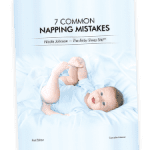
Today’s post will give you 7 tips to use when your baby won’t nap. Let’s get to it!
You know what’s cute? A cooing, babbling baby who’s grinning ear to ear as she holds onto her crib bars and jumps up and down on her mattress. So adorable!
Except that it’s nap time. And she’s not supposed to be cooing or babbling or jumping. She’s supposed to be SLEEPING, for Pete’s sake, and giving her poor parents a break!
Not so cute anymore, right?
I know a lot of you can identify with that picture because you have a baby who won’t nap.
You try and you try, but in spite of your best efforts, your little one is wide awake during nap time.
As always, we’re here for you! 🙂 Today, we’re exploring 7 tips for correcting your baby’s naptime issues.
7 Tips For Handling a Baby or Toddler Who Won’t Nap
- Make sure your baby’s room is “sleepy”. This may seem obvious, but it’s surprising how many parents don’t consider factors like light and noise when working through their children’s sleep issues. It’s true, though! If you want your baby to nap well, you need to do what you can to be sure that the room he naps in is “sleep-friendly”. Remember that nap time sleep is different than nighttime sleep. That’s one reason why naps can be so challenging. Naps happen when the sun’s up, for instance, so you may need to invest in some good blackout blinds in order to make your little one’s room nice and dim for naps.It can also be hard to keep your home quiet for nap time (this is especially true if you have older children!) So think about investing in a white noise machine that’ll help block out background noise while your little one sleeps. Don’t want to pay for a machine? Try downloading a white noise MP3, or a white noise app.
- Evaluate your baby’s daytime schedule. If you want your child to take regular, consistent, predictable naps, then you need to have a regular, consistent, predictable schedule in place. Sure, this schedule may need to be adapted every once in a while (to account for special occasions, trips, illness, etc.) But that majority of your days should look roughly the same. If they don’t, then it’ll be difficult, if not impossible, to help your baby or toddler nap well. What’s more, your daily schedule should be created with naps in mind. Try not to fill your schedule with activities and then squeeze naptime in here and there. Instead, build the naps in first, and make sure they coordinate around feedings/meals as well as morning wake time and bedtime. Once those things are established, fill in the schedule with activities (both yours and your baby’s).For help creating a sleep-friendly schedule, check out our Sample Sleep and Feeding Schedules page.
- Watch for overtiredness. This is especially important in the infant stage. Young babies become overtired very quickly, and an overtired baby is much harder to settle and put to sleep than a baby who’s rested and content. The same is true for toddlers. Most toddlers become increasingly “wired” and resistant to sleep as they become overtired. So watch for your baby’s or toddler’s tired cues (rubbing eyes, yawning, etc.), and act on them quickly.
- Create a consistent pre-nap routine. We’ve written before about the importance of having a consistent bedtime routine in place. It’s just as important to have a consistent nap time routine, especially if your baby or toddler is struggling to nap well. The routine doesn’t have to be long or complicated. It just needs to consist of a few calming, soothing activities. A few minutes spent cuddling, reading books, and singing songs are perfect. A routine like this will not only relax and soothe your child. It’ll also signal to him that nap time is approaching. This is important. Babies and toddlers thrive on routine and consistency, so having a regular pre-nap routine in place helps them know when it’s time to settle down and nap.
- Take the “schedule-busters” in stride. Sometimes, things that are totally outside of your control will come along and destroy your carefully-crafted schedule. Sleep regressions, for instance, can just obliterate any nap time progress you may have made. Same goes for illnesses, or teething. Even though disruptions like these are usually short-lived (a few days to a few weeks), they sometimes feel like they last for an eternity. Unfortunately, there’s no quick fix for schedule busters. (Unless your child is ill. In that case, seek medical care.) Most of the time, you have to simply go with the flow, doing the best you can to stay consistent and working not to create any new bad habits that you’ll have to undo later.
- Be smart about on-the-go naps. If your baby or toddler isn’t napping well, one of the problems may be that too many naps are happening on the go. While an occasional on-the-go nap is fine, the majority of your baby or toddler’s naps should happen at home/daycare/etc. Remember, moving sleep isn’t as restorative for babies and toddlers. If your baby or toddler is regularly catching naps on the fly, in the stroller or car, it can lead to a big sleep deficit over time. For those occasions when a nap simply has to happen on the go, consider adding some on-the-go napping products to your arsenal. Many companies make sun and sleep shades that are designed to fit over car seats, strollers, and pack-n-plays. These products can make it easier for little ones to sleep while mom and dad are out and about.
- Know your nap transitions. Sometimes, if your baby or toddler isn’t napping well, it’s not because there’s a problem that needs to be fixed. It’s because your little one’s nap needs are changing. Educate yourself about when common nap transitions occur, and how to manage them. Then, you’ll know better if your little one’s naptime resistance needs to be worked through, or if it may be time to drop a nap.
More nap and schedule help in our VIP Members Area:
- Mastering Naps and Schedules e-Book (unlimited member access at no extra cost!)
- Custom Schedule-Maker (unlimited access – make as many schedules as you’d like! Includes meal times)
- Nap Transitions audio course with Nicole Johnson
- Short Naps audio course with Nicole Johnson
- How To Put Your Child on a Schedule audio course with Nicole Johnson
- 5 Tips To Manage Nap Transitions [EXPANDED VIP MEMBER-ONLY VERSION]
- 5 Tips For Handling Tough Daycare Nap Schedules [EXPANDED VIP MEMBER-ONLY VERSION]
- Day-by-Day Nap Training Plan
- Downloadable Sleep/Nap Coaching Plan Workbook (learn how to create your own nap coaching plan!)
Not a VIP? Not a problem! Join today, and you’ll receive instant access to our vast online library of sleep coaching resources and much more!
Want FREE Baby Nap Help Right Away?
 Short or non-existent baby naps can be tough. But you don’t have to suffer through them! We have a ton of nap resources. One of the top resources is our free guide, 7 Common Napping Mistakes. Are you making any of these common nap mistakes? If so, they may be the cause of your baby’s non-napping. Download your free guide today and start putting the tips to use as early as your baby’s next nap!
Short or non-existent baby naps can be tough. But you don’t have to suffer through them! We have a ton of nap resources. One of the top resources is our free guide, 7 Common Napping Mistakes. Are you making any of these common nap mistakes? If so, they may be the cause of your baby’s non-napping. Download your free guide today and start putting the tips to use as early as your baby’s next nap!








